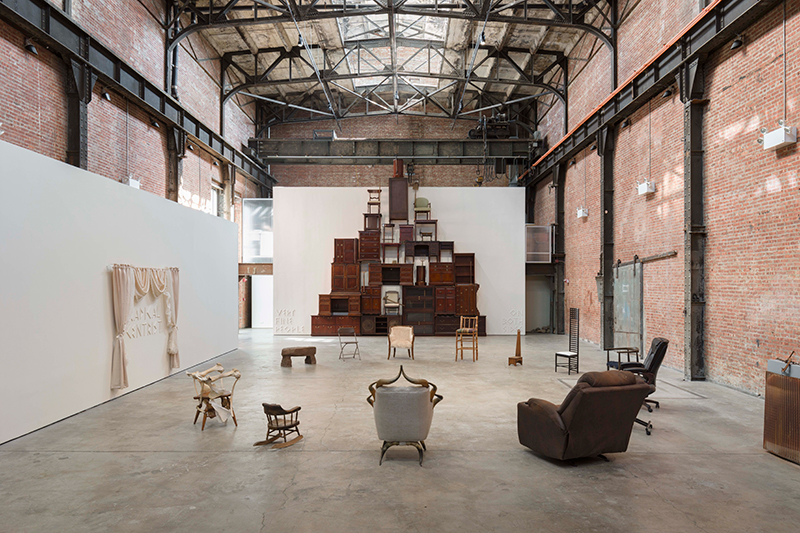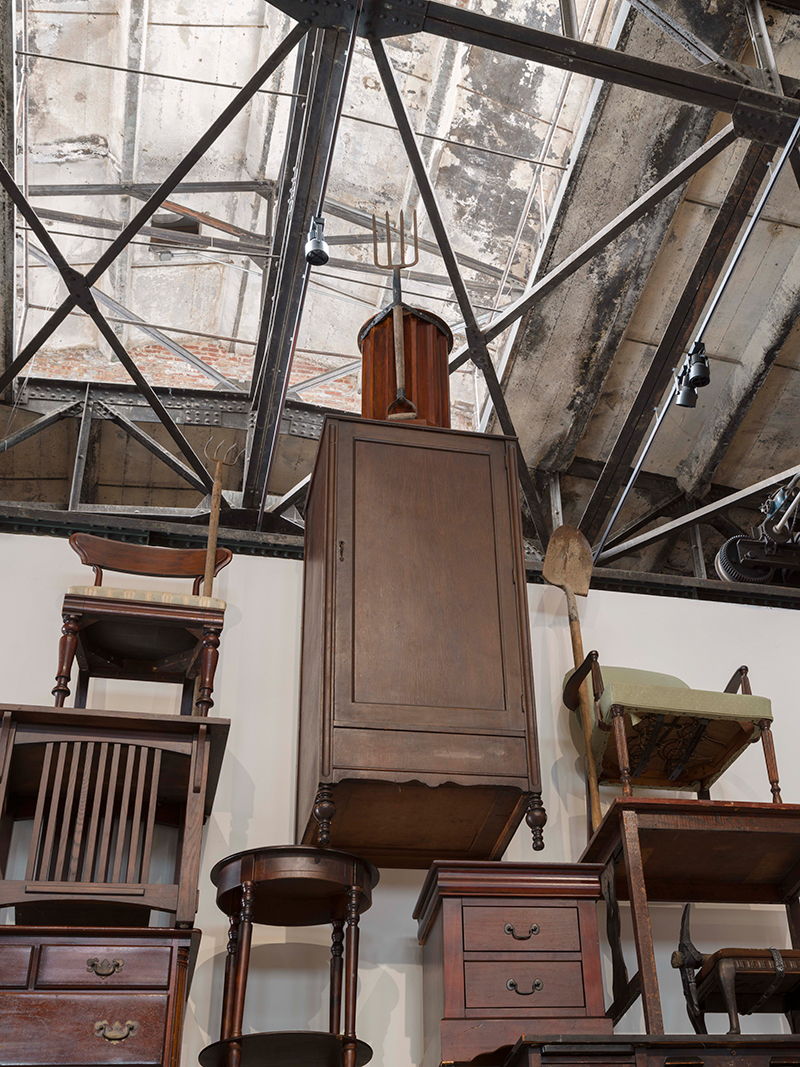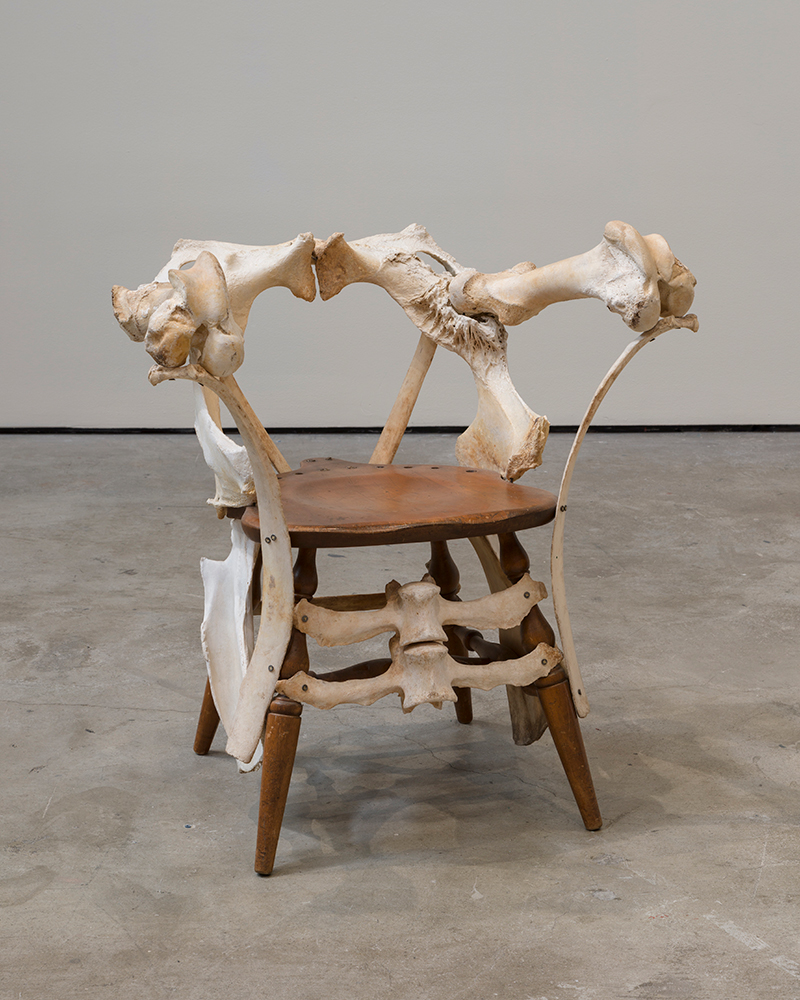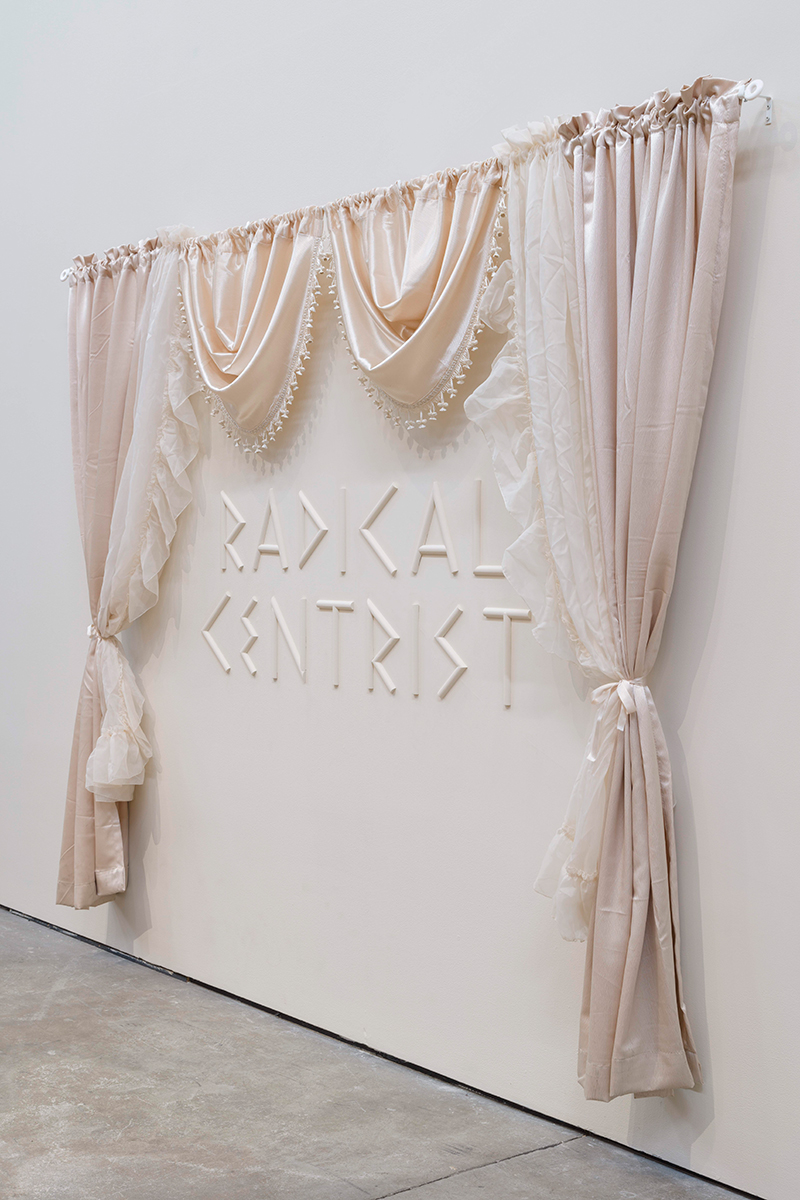by Dagmara Genda // Sept. 27, 2022
Last week Henrike Naumann opened her first exhibition in the U.S. at New York’s SculptureCenter. Like many of her shows, ‘Re-Education’ consists of installations made of found furniture and design objects in order to examine, in a tongue-in-cheek way, the relationship between (often questionable) politics and home décor. For an artist who works so intimately within an East German context—sourcing from her grandfather’s art practice, the far-right politics of her hometown Zwickau, to her own childhood home—moving into a foreign milieu has posed a unique challenge for her.

Henrike Naumann: ‘Re-Education,’ 2022, installation view, SculptureCenter, New York // Courtesy of the Artist and SculptureCenter, Photo by Charles Benton
‘Re-Education,’ references the anti-fascist education programs implemented by the Allied Forces in post WWII Germany, and the later self “re-education” for East Germans who had to adapt to capitalist post-1989 reality. It also alludes to Naumann’s own exposure to American culture, which happened largely through imported cartoons and popular television she watched as a child. Now, working with American political culture in the U.S. itself, the artist has been forced to “re-educate” herself in the reality of something she only experienced second hand. Shortly before the opening of her exhibition, we sat down with Naumann to talk about the challenges of working as an outsider, the particularities of the American context and where she thinks her future projects are heading.
Dagmara Genda: You have now spent two months in New York in preparation for your show. Was a large part of that time spent doing research?
Henrike Naumann: And production. Everything is produced here in New York. I didn’t bring anything from Germany, which is interesting because I didn’t know what I would find here nor did I know how the work would develop.
DG: Where have you been looking for objects?
HN: E-Bay mostly, but also Craig’s list. It is a big country of stuff! Most of the things come from New York and New Jersey. I noticed that there is a lot of rural aesthetic, a kind of longing for nature.
This is my first time in the US, but I grew up watching American TV. So I had an idea of what American aesthetics are, but when I saw these things for the first time, I had to ask myself if what I was seeing was from the set for a television show or if it was actually real!

Henrike Naumann: ‘Rustic Traditions,’ 2022, detail // Courtesy of the Artist and SculptureCenter, Photo by Charles Benton
DG: Up to this point your work has been informed by first hand experience in East Germany and has had an intimate, domestic feel to it. Even if you grew up watching American TV, it is still only one window onto the American experience. Is the intimate and domestic still important in this installation?
HN: It was challenging because I had no expertise and furniture to hide behind. I just came with a certain way of looking at things and a set of interests. Rather than claiming expertise, I want to learn something. So because I do not have any expertise here, I rely on people. I have been asking people what they see and what objects mean to them.
Nevertheless, I came with hundreds of images from TV shows. Instead of looking at the everyday furniture that everyone has, I was looking at the most extreme things—things that could be real furniture but could also be props from a sitcom or a horror film. One of the places I would go to find things were estate sales from film productions.
The other challenge for me is the size of the SculptureCenter. It is so much bigger than the spaces I have worked in before. So there is no illusion of intimacy or domestic space.
DG: When you say you ask people about objects, who do you ask? People on the street or do you visit people’s homes?
HN: I try to visit people’s homes, but, of course, it is not so easy to ask people on the street to take me home. It is usually people I know through work or people I get introduced to at the SculptureCenter, so then of course, it is a specific group of people who have a relationship to art and design.
The relationship to furniture is different in New York. People move a lot here and they have smaller apartments. The attachment to objects is different. This is why I am more interested in furniture extremes.
One thing that is central in this show is the recreation of a meme. The meme is called the “Horseshoe Theory of Chair Design and Function.” I started looking for an example of every chair in this meme. This was the inspiration for the bone chair in the show. The meme links a chair made out of bones to fascism. So I found this particular cattle bone chair from Savannah, Georgia on E-Bay.

Henrike Naumann: ‘Horseshoe Theory,’ 2022, detail, various materials // Courtesy of the Artist and SculptureCenter, Photo by Charles Benton
Of course this is also a projection and interpretation of me as an artist in the work. I might choose something because I like it or I think its funny, but nevertheless it becomes a part of a larger discussion about, not necessarily associations, but atavistic explanations.
DG: When you were searching for things, did you notice any crossovers with German design or German preferences?
HN: The aesthetic in Germany was very much inspired by American TV shows. Interestingly, my American colleagues also experienced a kind of melancholia when looking at my work in the past. They were, for example, reminded of their childhood homes in California in the 80s. But everything has drastically changed since then.
DG: Are you moving away from the East German context that has informed your work in the past?
HN: I was working with East Germany as a subject because it always seemed to come up politically even if Germany has been united for 30 years now. The divide still creeps up when it comes to election results or wage inequalities. The experience and methods I developed with that work are now being applied to new places and aesthetics, which I want to explore to get a sense of the bigger picture.
Instead of relying on my past knowledge, I am now more interested in going to places where I do not know the context, where I can learn something.

Henrike Naumann: ‘Radical Centrist,’ 2022, installation view // Courtesy of the Artist and SculptureCenter, Photo by Charles Benton
DG: How do you decorate your own home?
HN: [laughs] I get that question a lot! You know, I would love to say that it looks just like my installations. Being here made me realise that I actually just live between archive boxes of all the concepts I have ever come up with. I have never really noticed that before I came here! I am living with all the ideas I have ever had.
Exhibition Info
SculptureCenter
Henrike Naumann: ‘Re-Education’
Exhibition: Sept. 22–Feb. 27, 2023
sculpture-center.org
44–19 Purves St, Long Island City, NY 11101, United States, click here for map






















